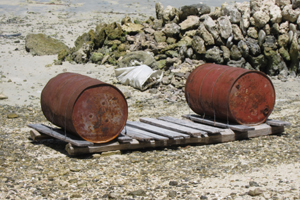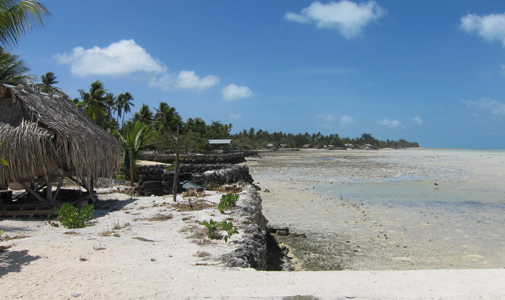Maria Louise Bønneløkke Robertson
Tarawa, January 2011
On South Tarawa there is a great demand for land, land gets increasingly scarce as the demographic pressure keeps rising. One way of dealing with this scarcity is through land reclamation. Land reclamation is both undertaken as a public enterprise, for example the main port in Betio is constructed on reclaimed land, but also families undertake the task of reclaiming land. The basic concept is that on the sandy lagoon side of the island people build up sea walls at low tide. When the sea wall is constructed sand is mined from the floor of the lagoon at low tide. When the wall is filled in with mined sand it adds a new square of land to the island. The reclaimed land varies in size from less than 100 m2 to several hundred m2. The following is an account of a visit to an old man from South Tarawa. He first lost his reclaimed land in 1981to a big wave from the lagoon. The wave washed away the sea wall and many of his belongings. Today, the sea wall is constructed once again. Parts of it are now cemented to make it a more durable structure. The cement was a donation from the old man's church, the Seventh Day Adventist Church. Today, it is the old man's son and the son's family that live on the land plot
When you enter the land plot near the main road, the first thing you see is the well, it is quite a wide well and the water is 1-2 meters below the ground surface. The sides of the well are supported by metal structures, and on top of the well are the remains of an old boat. The boat is angled so that it shelters the well from dust from the main road and from the vegetation that is atop of it, but the angle also allows quick access to the well from the residential side. As you walk past the well you enter the residential area. In the far end furthest away from the well is the kitchen and the ‘toilet'. The toilet is placed almost on top of the sea wall so as the wastewater runs straight into the lagoon. In the middle are the sleeping quarters, called the buia, and in the other corner across from the kitchen is what resembles a kiakia, which is a smaller version of a buia, and which can be moved around. This kiakia was a raised structure with a view of the lagoon and it was used for sleeping in. The place was very well kept, all the leaves had been swept away, and it the surface of the land plot was covered in finely grained white sand.
The old man took us to see the seawall, which is his big concern. The front side of the seawall facing the lagoon was cemented up to around the high tide mark (this visit took place during high tide). On top of the cemented seawall there was yet another meter or so which was just coral rock. This concerned him 'If a big wave come it will just wash away this sea wall because there is no cement.' The sides of the seawall were only built from coral rock. There were several coconut trees on the land, they were low (2-2.5 meters) and had low hanging coconuts on them and the son's wife explained that they also had 3 breadfruit trees. There was a tree at the very front of the land plot by the sea wall, attached to it was a plastic line, and at the end of the line was the 'boat', as the old man called it. This is a technology that allowed them to collect coral stones at low tide and bring them in at high tide. It is two oil  barrels each attached to the sides of a board of wood about the size of a 4-person dining table. When the tide is going out you sail this construction on the low water into the lagoon where the coral rocks can be found. At low tide several hundred meters of the lagoon floor is exposed, and at this time you can collect the coral rocks. When the tide comes in the ‘boat' will be filled with coral rocks and with the help of the incoming water the boat is floated back to the shore.
barrels each attached to the sides of a board of wood about the size of a 4-person dining table. When the tide is going out you sail this construction on the low water into the lagoon where the coral rocks can be found. At low tide several hundred meters of the lagoon floor is exposed, and at this time you can collect the coral rocks. When the tide comes in the ‘boat' will be filled with coral rocks and with the help of the incoming water the boat is floated back to the shore.
In the surface of the high tide another coral stone construction was visible. It was the beginning of a new land reclamation project. The new sea wall extended another 10 meters into the lagoon, one side was about a meter high and the front wall could be glimpsed under the surface of the high tide, but was still very low. I asked the old man how long his son had been working on the sea wall, and when the new sea wall will be finished. The son had been working for 5 months on the sea wall and the old man estimated 2 years in total to finish the sea wall. However, this structure will have no cement in it whatsoever.
I asked the old man to tell me more about his well. He explained that it is a very special well, and he continued telling me the story of how he and his family dug the well. It was in 1986, before they started digging the old man told the all the men who were digging to pray together that they would find good water. They started digging and soon they reached the water level. It is like milk! The men exclaimed, because the water was mixing with the fine coral sand, which gave the water a milky appearance. The old man warned: Don't taste it! Keep digging until the water is up to your knees. When the water reached their knees, the old man said another prayer that the water would be good. Then they fetched a cup and started tasting the water. Everyone raised their eyebrows in surprise as they tasted the water, and in the end the old man tasted, and he said ‘yes, it tastes like rainwater'. The old man explained that all the other wells on the other side of the road and their neighbors' are salty, but we have well water like rainwater, we don't use any other water than this (this means that they do not rely on the publically reticulated water from the government). It was getting dark and the old man's son turned on an electric florescent tube that hung from the tree that was anchoring the boat.

